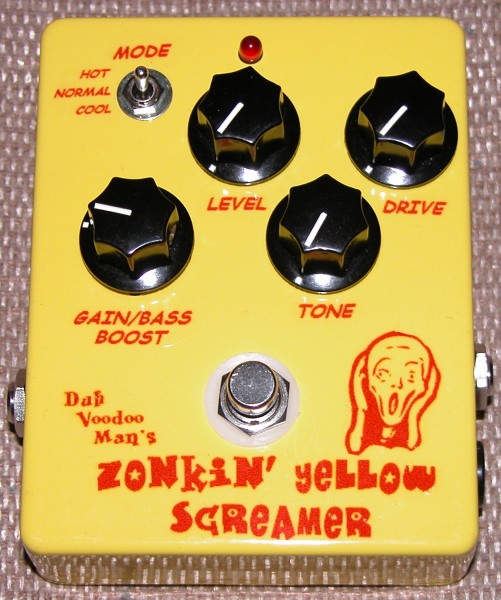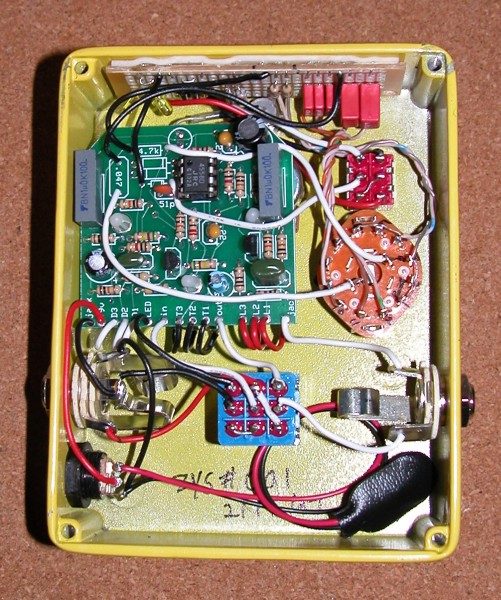 |
 |
My Zonkin' Yellow Screamer overdrive pedal, a.k.a. "ZYS", is an extensively modified version of BYOC's "Overdrive" pedal, based upon the revered Ibanez Tube Screamer TS-808 circuit. This legendary effect owes its reputation to the many respected guitarists who've used it over the years, notably Stevie Ray Vaughan. After being out of production for many years, Ibanez now sells a "reissue" version of the famous TS-808, but it typically sells for $170. Don't get me wrong--it's a great overdrive pedal--but if you know anything about electronics at all, one peek "under the hood" will show you how outrageously overpriced that is, especially for a mass-produced pedal! Consider the fact that the TS-9 model, which basically differs from the TS-808 by one resistor and one capacitor, plus a slightly different enclosure, generally sells for $99!
The popularity and mystique of the Tube Screamer has naturally spawned many imitators and derivatives, and there are countless boutique "clones" sold that claim to be better than the original. Some of them command fairly astronomical prices; one highly regarded model I've seen goes for $400! It's a fine quality, hand-made pedal, but--C'MON!--four C-notes for a souped up Tube Screamer?? Gimme a break!! It's interesting that most of these boutique pedals are based upon a circuit that differs little or not at all from the basic TS circuit designed in the late 70's. The most common differences are what operational amplifier chip, i.e. "opamp" it uses, what type of diodes are used for signal clipping to induce the pedal's distinctive distorted tone, and how various capacitors and resistors are sized to determine the pedal's gain and bass response characteristics
When I first became interested in bulding my own effects pedals, I decided the first one would be a TS-808 clone. I quickly found the BuildYourOwnClone.com website and zeroed in on their most popular model--the Overdrive. This pedal is a faithful reproduction of the vintage TS-808 circuit, with a couple of notable enhancements. First, the pedal is "true bypass", meaning that when the pedal is not turned on, its circuit is physically isolated from the signal path. This removes the possibility of the dreaded "tone-sucking" that some pedals can cause, even when turned off. Secondly, the design incorporates an opamp socket rather than soldering the opamp directly to the pedal's PCB. This allows the owner to switch out opamps and use the one that suits their personal taste. BYOC even includes a second opamp in their kit, the popular RC4558P, to supplement the "vintage-correct" JRC4558D. And thirdly, the PCB layout allows the builder to choose either of two modes of diode clipping--symmetrical per the original TS-808, or asymmetrical, which has gained wide popularity for its reputed smoother and more musical sound. Diodes are provided in the kit for both clipping modes.
I initially built the pedal exactly per the kit directions, using the asymmetric clipping configuration. The pedal worked correctly the first time it was plugged in, and the tone sounded great. But being a tinkerer at heart, I started reading about possible modifications to the pedal's stock design and quickly became intrigued by the tonal flexibility that could be added with a few reasonably simple modifications. I settled upon three new features that I wanted to add:
- Two switchable gain ranges--a stock and a high-gain setting that boosted the maximum pedal gain by a factor of over four. This could be accomplished with two switchable resistors.
- Three switchable bass-rolloff frequencies. The classic TS circuit is well-known for accentuating the mid-range frequencies, creating a frequency response "hump" that is a key part of its signature tone. However, by going to three switchable capacitors of different ratings, the response range could be lowered by degrees to flatten out this hump and give the pedal more bottom end.
- Three switchable clipping modes. In addition to the asymmetric silicon diode clipping I installed initially, I wanted to add two additional clipping modes with distinctly different tones. I settled on germanium diodes for a warm, smooth and bluesy tone, and yellow LED's for a muscular, Marshall-like tone.
While none of these modifications are the least bit original, I did come up with a somewhat innovative way to integrate the gain and bass rolloff functions into a single control. By carefully selecting the capacitor and resistor values controlling these two parameters, I was able to use a 2-pole, 6-position rotary switch to create a composite control for the gain/bass rolloff. The first three positions use the stock gain setting and decrease the bass rolloff frequency (thereby increasing the bass output) in two steps. The second three positions bump the gain factor up by over 4x, and offer the same three increments of bass response. Together with a three-position toggle switch for the different clipping modes, the ZYS offers the user 18 different combinations of gain, bass rolloff and clipping mode. Very flexible!!
It doesn't stop there, though. The opamp socket offers the user even more flexibility by changing to different opamps with subtly different tonal characteristics. In addition to the JRC4558D and RC4558P provided by BYOC, I've used several other compatible opamps in my ZYS. I've yet to use one that I thought sounded bad, but some definitely sound better to my ear than others. My current favorite is the TI TCP2272ACP, which seems to have a great combination of clarity/note definition while still offering a nice, smooth overdrive tone. These go for about $1.50 apiece at Mouser.com, so we're not talking expensive add-ons here. I've packaged four different opamps with the ZYS pedals I've sold, including the three mentioned above along with an STM LM833N, a low-noise opamp that's particularly suited to high gain range use.
One last thing--the bottom photo is a "gut shot" of the pedal. The 2x6 rotary switch is the oblong light brown object at center-right, and the 3-way toggle for clipping mode selection is the rectangular red object directly above it. The various switchable components that define the gain, bass rolloff and clipping modes are mounted on the strip of "perfboard" (available at most Radio Shack stores) that is mounted along the top inside edge of the enclosure. Wires then connect these components and their activating switches back to the appropriate contact points on the PCB.
 |
Take a look at Duh Voodoo Man's Guitars & Amps |
 |
Go to Duh Voodoo Man's Home Page |
 |
Just close this browser window, please... |